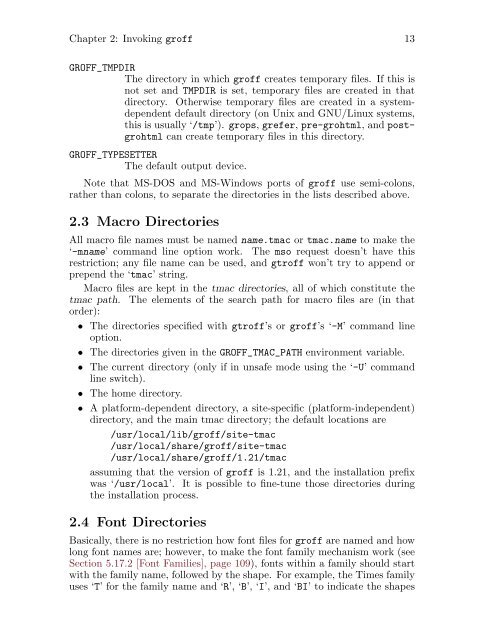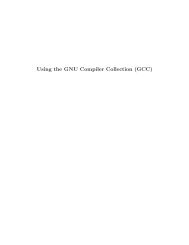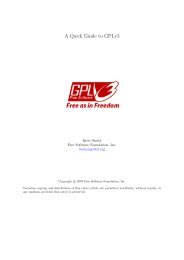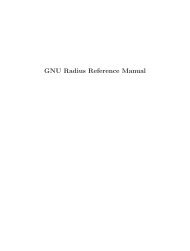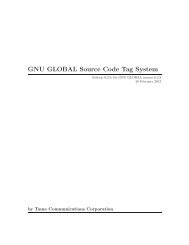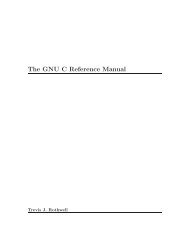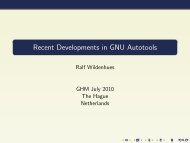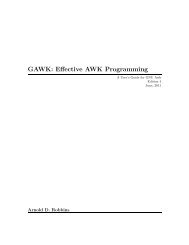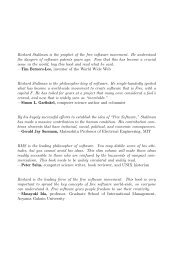by Trent A. Fisher and Werner Lemberg - The GNU Operating System
by Trent A. Fisher and Werner Lemberg - The GNU Operating System
by Trent A. Fisher and Werner Lemberg - The GNU Operating System
Create successful ePaper yourself
Turn your PDF publications into a flip-book with our unique Google optimized e-Paper software.
Chapter 2: Invoking groff 13<br />
GROFF_TMPDIR<br />
<strong>The</strong> directory in which groff creates temporary files. If this is<br />
not set <strong>and</strong> TMPDIR is set, temporary files are created in that<br />
directory. Otherwise temporary files are created in a systemdependent<br />
default directory (on Unix <strong>and</strong> <strong>GNU</strong>/Linux systems,<br />
this is usually ‘/tmp’). grops, grefer, pre-grohtml, <strong>and</strong> postgrohtml<br />
can create temporary files in this directory.<br />
GROFF_TYPESETTER<br />
<strong>The</strong> default output device.<br />
Note that MS-DOS <strong>and</strong> MS-Windows ports of groff use semi-colons,<br />
rather than colons, to separate the directories in the lists described above.<br />
2.3 Macro Directories<br />
All macro file names must be named name.tmac or tmac.name to make the<br />
‘-mname’ comm<strong>and</strong> line option work. <strong>The</strong> mso request doesn’t have this<br />
restriction; any file name can be used, <strong>and</strong> gtroff won’t try to append or<br />
prepend the ‘tmac’ string.<br />
Macro files are kept in the tmac directories, all of which constitute the<br />
tmac path. <strong>The</strong> elements of the search path for macro files are (in that<br />
order):<br />
• <strong>The</strong> directories specified with gtroff’s or groff’s ‘-M’ comm<strong>and</strong> line<br />
option.<br />
• <strong>The</strong> directories given in the GROFF_TMAC_PATH environment variable.<br />
• <strong>The</strong> current directory (only if in unsafe mode using the ‘-U’ comm<strong>and</strong><br />
line switch).<br />
• <strong>The</strong> home directory.<br />
• A platform-dependent directory, a site-specific (platform-independent)<br />
directory, <strong>and</strong> the main tmac directory; the default locations are<br />
/usr/local/lib/groff/site-tmac<br />
/usr/local/share/groff/site-tmac<br />
/usr/local/share/groff/1.21/tmac<br />
assuming that the version of groff is 1.21, <strong>and</strong> the installation prefix<br />
was ‘/usr/local’. It is possible to fine-tune those directories during<br />
the installation process.<br />
2.4 Font Directories<br />
Basically, there is no restriction how font files for groff are named <strong>and</strong> how<br />
long font names are; however, to make the font family mechanism work (see<br />
Section 5.17.2 [Font Families], page 109), fonts within a family should start<br />
with the family name, followed <strong>by</strong> the shape. For example, the Times family<br />
uses ‘T’ for the family name <strong>and</strong> ‘R’, ‘B’, ‘I’, <strong>and</strong> ‘BI’ to indicate the shapes


